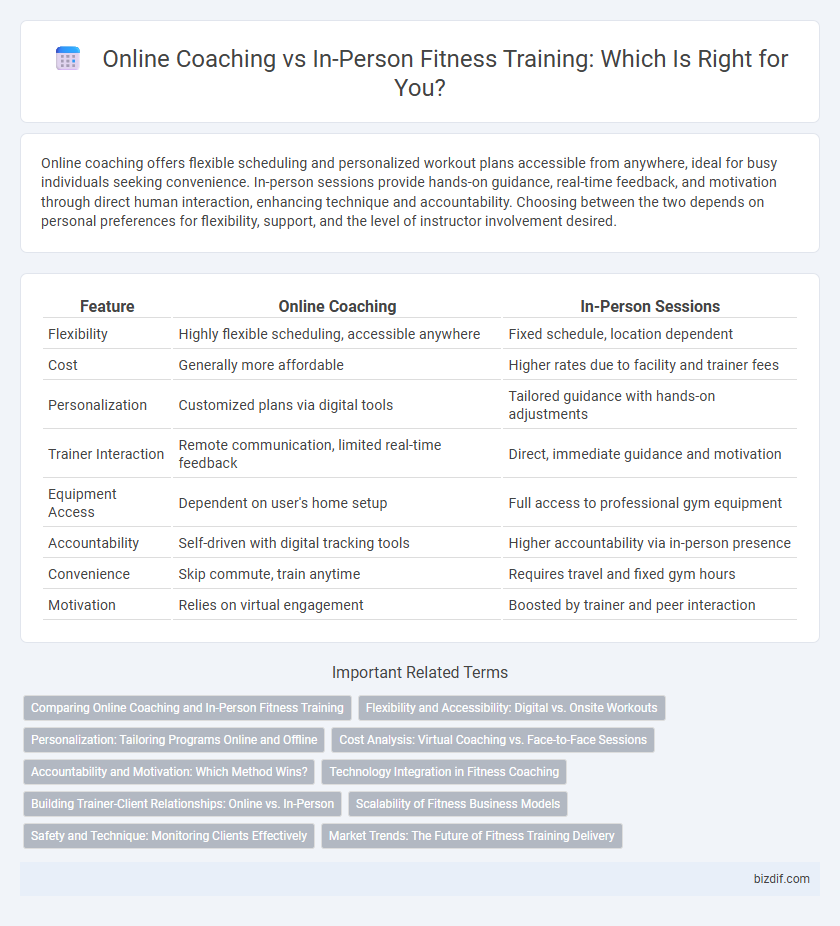Online coaching offers flexible scheduling and personalized workout plans accessible from anywhere, ideal for busy individuals seeking convenience. In-person sessions provide hands-on guidance, real-time feedback, and motivation through direct human interaction, enhancing technique and accountability. Choosing between the two depends on personal preferences for flexibility, support, and the level of instructor involvement desired.
Table of Comparison
| Feature | Online Coaching | In-Person Sessions |
|---|---|---|
| Flexibility | Highly flexible scheduling, accessible anywhere | Fixed schedule, location dependent |
| Cost | Generally more affordable | Higher rates due to facility and trainer fees |
| Personalization | Customized plans via digital tools | Tailored guidance with hands-on adjustments |
| Trainer Interaction | Remote communication, limited real-time feedback | Direct, immediate guidance and motivation |
| Equipment Access | Dependent on user's home setup | Full access to professional gym equipment |
| Accountability | Self-driven with digital tracking tools | Higher accountability via in-person presence |
| Convenience | Skip commute, train anytime | Requires travel and fixed gym hours |
| Motivation | Relies on virtual engagement | Boosted by trainer and peer interaction |
Comparing Online Coaching and In-Person Fitness Training
Online coaching offers flexible scheduling, personalized workout plans, and accessibility regardless of location, leveraging digital tools for progress tracking and virtual motivation. In-person fitness training provides direct supervision, immediate feedback, hands-on adjustment, and often a more motivating environment through face-to-face interaction with trainers. Both methods cater to different needs, with online coaching excelling in convenience and scalability, while in-person sessions maximize accountability and personalized form correction.
Flexibility and Accessibility: Digital vs. Onsite Workouts
Online coaching offers unmatched flexibility by allowing clients to access workouts anytime and anywhere, eliminating geographic and scheduling constraints. In-person sessions provide hands-on guidance and immediate feedback but require fixed appointments and travel, which can limit accessibility for some individuals. Digital workouts cater to diverse lifestyles by enabling personalized routines that fit seamlessly into busy schedules, enhancing overall adherence and consistency.
Personalization: Tailoring Programs Online and Offline
Online coaching leverages digital tools such as apps, video calls, and wearable technology to provide highly personalized fitness programs based on real-time data and progress tracking. In-person sessions offer hands-on adjustments and immediate feedback, enhancing exercise technique and motivation through direct interaction. Both methods tailor programs to individual needs, but online coaching excels in continuous monitoring while in-person training shines in tactile guidance.
Cost Analysis: Virtual Coaching vs. Face-to-Face Sessions
Online coaching offers a more cost-effective alternative to in-person fitness sessions by eliminating travel expenses and reducing trainer fees, often averaging 30-50% less. In-person sessions typically include higher overhead costs, such as facility rentals and equipment maintenance, which contribute to increased prices. Virtual coaching platforms also provide flexible payment plans and subscription models, enhancing affordability for a broader range of fitness enthusiasts.
Accountability and Motivation: Which Method Wins?
Online coaching provides flexible scheduling and digital tracking tools that enhance accountability by allowing real-time progress monitoring and personalized feedback. In-person sessions offer direct human interaction, fostering immediate motivation and emotional support through face-to-face encouragement and hands-on adjustments. Research shows clients combining both methods achieve higher consistency and motivation levels, leveraging technology's convenience alongside personal trainer engagement.
Technology Integration in Fitness Coaching
Online coaching leverages advanced technology integration such as wearable devices, real-time video feedback, and AI-driven workout analytics to personalize fitness training and track progress accurately. In-person sessions benefit from direct physical guidance and immediate correction but often lack the continuous data collection and remote access offered by online platforms. The fusion of technology with fitness coaching enables scalable, flexible, and data-driven training experiences that enhance performance and motivation beyond traditional methods.
Building Trainer-Client Relationships: Online vs. In-Person
Building trainer-client relationships through online coaching relies heavily on clear communication, consistent feedback, and personalized digital tools to foster trust and motivation. In-person sessions advantageously offer immediate physical presence, enabling trainers to provide hands-on adjustments and more intuitive emotional support. Both methods necessitate intentional engagement strategies, but the tactile and social dynamics of in-person training often deepen relational bonds more quickly.
Scalability of Fitness Business Models
Online coaching offers significant scalability advantages for fitness businesses by enabling trainers to reach a global audience without geographical constraints. In-person sessions limit scalability due to physical location and time availability, restricting client volume and revenue potential. Leveraging digital platforms and virtual tools allows for automated scheduling, personalized programming, and group coaching, maximizing business growth and client engagement efficiently.
Safety and Technique: Monitoring Clients Effectively
Online coaching employs video analysis and real-time feedback tools to monitor clients' technique, ensuring safe execution of exercises despite physical distance. In-person sessions allow coaches to provide immediate hands-on adjustments and closely observe clients' form to prevent injuries. Both formats utilize technology and professional expertise to prioritize safety, but in-person training offers a more direct method for correcting technique and reducing injury risks.
Market Trends: The Future of Fitness Training Delivery
Fitness training is increasingly shifting towards online coaching, driven by rising demand for flexibility and personalized programs accessible from any location. Market trends indicate that digital platforms utilize AI-driven progress tracking and interactive video sessions to enhance user engagement and results. Despite this growth, in-person sessions remain valued for hands-on guidance and motivation, suggesting a hybrid model will dominate the future fitness training landscape.
Online coaching vs In-person sessions Infographic

 bizdif.com
bizdif.com